
When it comes to hunting, there are many ways to hunt different animals, and hunting wild pigs is one of the most unique. Where predator or big game hunting typically revolves around getting one perfect shot on an animal, hunting wild pigs in the United States is more about extermination due to the billions of dollars in damage they cause to farmland each year. While getting a perfect first-round hit is still imperative, getting quick follow-up shots on other pigs is just as important. I have been hunting wild pigs for nearly a decade, and I will share some things I wish I would have known or had for the first time I went hog hunting.
Rifles For Hog Hunting:
A reliable semi-automatic rifle is the go-to for hog hunting. While bolt actions can be lighter weight and typically more accurate out of the box, a quick-shooting semi-automatic rifle is going to be the best choice when the goal is exterminating wild hogs. The choice between bolt guns and semi-autos comes down to your type of hunting, but for me, I started running a pieced-together Aero Precision M5 AR10 around two years ago and have no regrets. Choosing the caliber to have a rifle chambered in is another whole debate, and while many get the job done, 308 and 7.62×39 seem to be the most common cartridges used. While 223/556 is fully capable of killing wild pigs, I switched to 308 after finding out how many shots it took to bring down some pigs. While some would drop right away with a well-placed shot from an AR15, others soaked up multiple rounds and kept running only to die in the woods. Switching to an AR10 chambered in 308 essentially eliminated this from happening. I have found it to do a much better job of dropping pigs when they are hit.
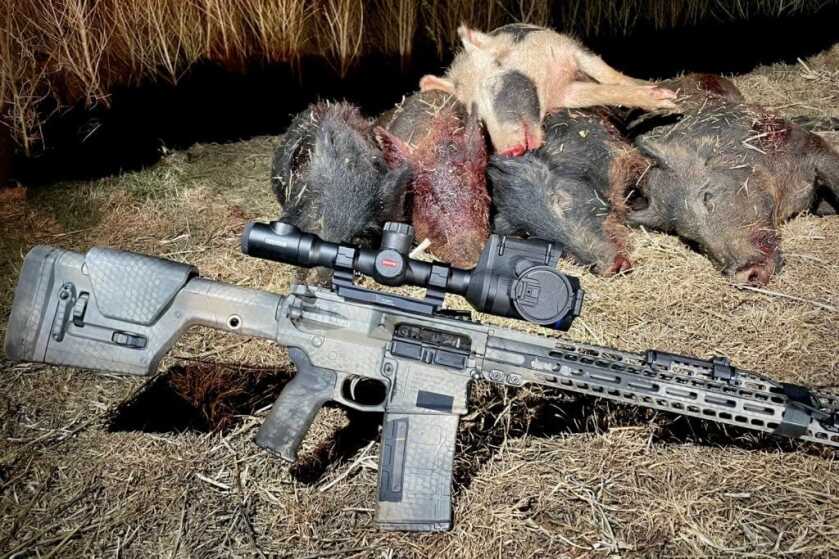
Thermal Scopes for Hog Hunting:
To first hunt pigs, you have to see them. For the most part, wild pigs stay in the brush and don’t move much during the day. However, they love to come out in groups at night. While I have successfully shot a few during the day, the vast majority have been shot at night with thermals. For this reason, a thermal scope is at the top of my list. It wasn’t until I had a thermal that I realized how many animals are moving at night. Running night vision for around 2 years before thermal, I could find some pigs out on our farmland, but I couldn’t see much in the shadows or rows of the standing crops. Everything changed when I bought my first thermal, the Pulsar RXQ30V (which has been discontinued). This optic changed everything. I had it on a quick-detach mount so I could easily use it as a scanner, and then mount it back to my rifle while retaining my zero when it was time to shoot. The power of thermal is that any warm-blooded creature emits radiation in the form of heat. This radiation is picked up by the sensor in thermal devices and makes the creature glow and really stand out from its surroundings. Due to the effectiveness of thermal, I can see pigs and coyotes out in the shadows or brush where I would have never detected them with night vision alone. This however is the most expensive piece of my hunting gear. Entry-level thermal scopes start around $2,000 and can get quite pricey with the better components included in more premium units.
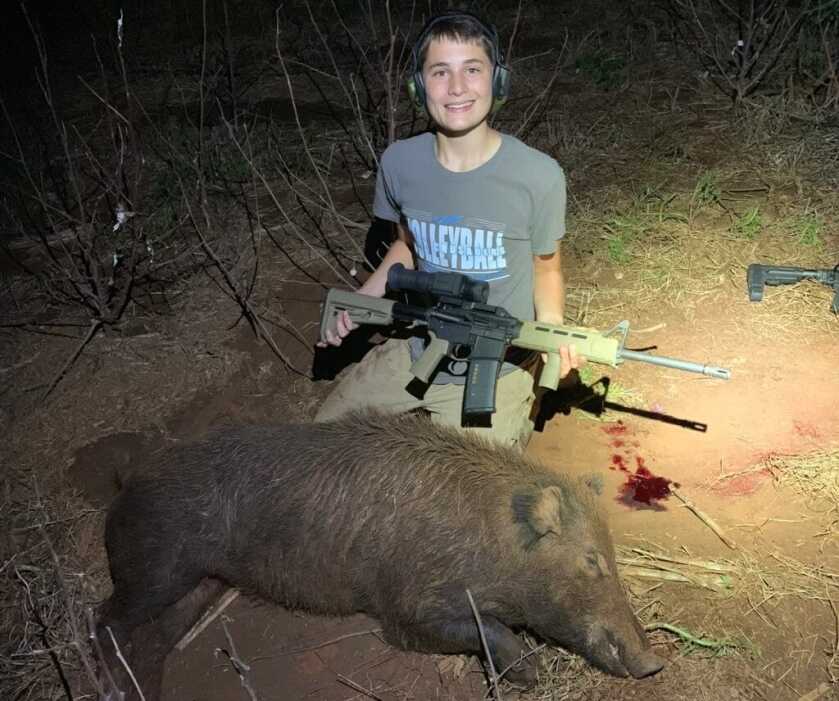
Tripods for Pig Hunting:
My next recommendation for hog hunting would be a tripod. When I first started hunting using thermals, I just tried to sneak up within 50 or so yards from pigs at night and would free-hand my shots. While I was able to get a few good shots at first, I would be all but worthless trying to shoot at the pigs as they ran off and got past 150 yards. Using a tripod was an absolute game-changer. Not only was I able to get better first-round shots, but I could accurately take shots out to a few hundred yards. A tripod also helps for quick follow-up shots on moving targets. Not only was I steady, but I had a solid shooting platform that sat up higher than the brush or stubble to maintain an unobstructed field of view. BOG makes some great affordable options such as the BOG DeathGrip for those just getting started. I have owned and used the Kopfjager K800 carbon fiber tripod with great success over the past two years and the reduced weight has been much appreciated for the longer stalks.
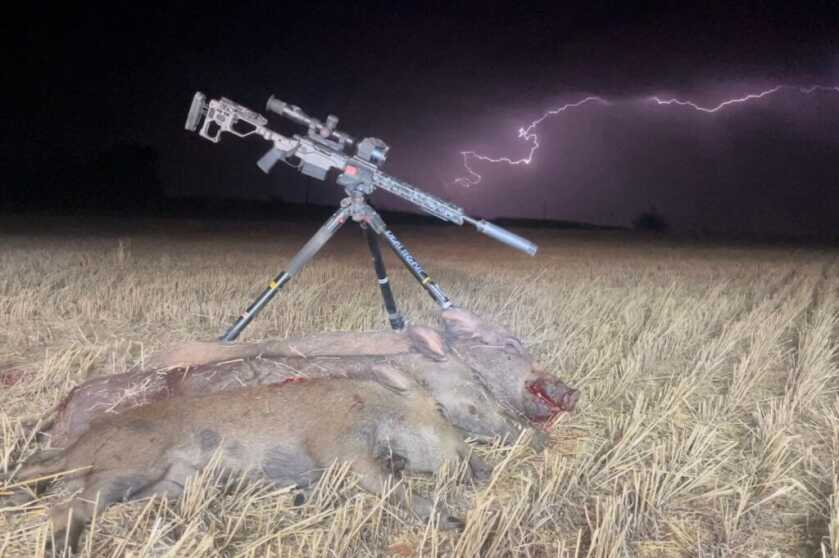
Suppressors for Hog Hunting
While a suppressor is not entirely necessary, using one has quite a few perks. Keeping the noise down is a courtesy, and helps to keep neighbors and cattle from getting freaked out. Not only is using a suppressor the polite thing to do, but it also reduces and changes the sound signature when shooting. While suppressors are not Hollywood quiet, I have had many times where after I fire the first shot, a group of pigs will run in my direction due to the sound bouncing off the trees in the distance. Suppressors also help reduce muzzle blasts which can be quite bright at night and would send pigs running in the opposite direction. They also slightly increase velocity so you can get +10 damage when trying to take down that massive boar. My first suppressor and the one I am still using is a SilencerCo Hybrid 46. It has worked great from 9mm up to 300 Weatherby magnum for me.

Boots for Hog Hunting:
As previously stated, hog hunting seems to be the most effective at night when the groups migrate out into the open fields. Due to this, I am always stumbling around in the dark on pretty uneven ground. Wild pigs are notorious for the destruction they cause to crops as well as how badly they rut up fields. These ruts in combination with other stumbling blocks create a challenging environment for your ankles. While in the past I have mostly used slip-on work boots when out hunting, investing in a quality set of boots with ankle support has given me some good peace of mind. I have rolled my ankles multiple times after stepping in a hole while trying to navigate in the dark. When using a set of lace-up boots, your ankles will be better protected while navigating uneven terrain. There are a lot of good options out there, but I purchased the Salomon Quest 4 Gore-Tex and put quite a few miles on them without issue this year.
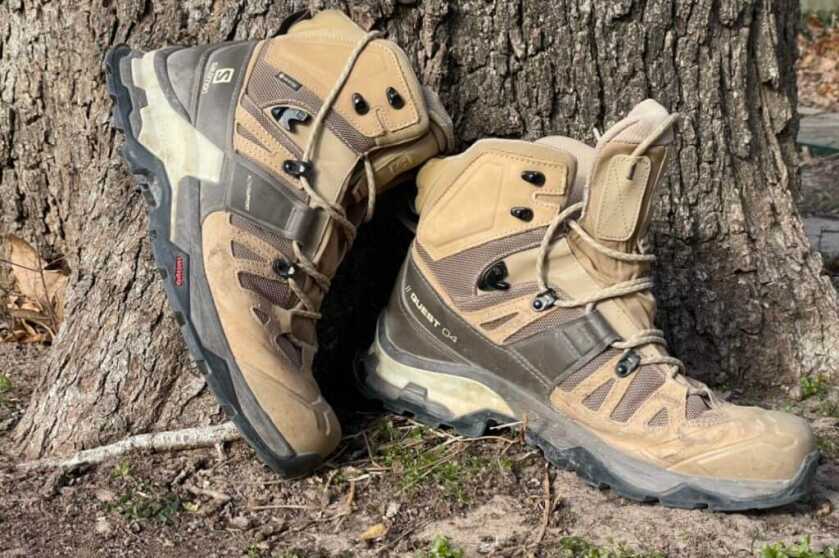
Conclusion
For me, each of these items came after years of trial and error. I didn’t have many people to consult when I first started hunting, so I lived and learned. Hopefully, this list helps give a jump start into some great gear for hog hunting and saves y’all from some of the trial-and-error of this hunting journey. After saving up to purchase more of these tools, my effectiveness in the field increased dramatically. Skill is priceless, but quality gear without a question increases effectiveness.

*** Buy and Sell on GunsAmerica! ***


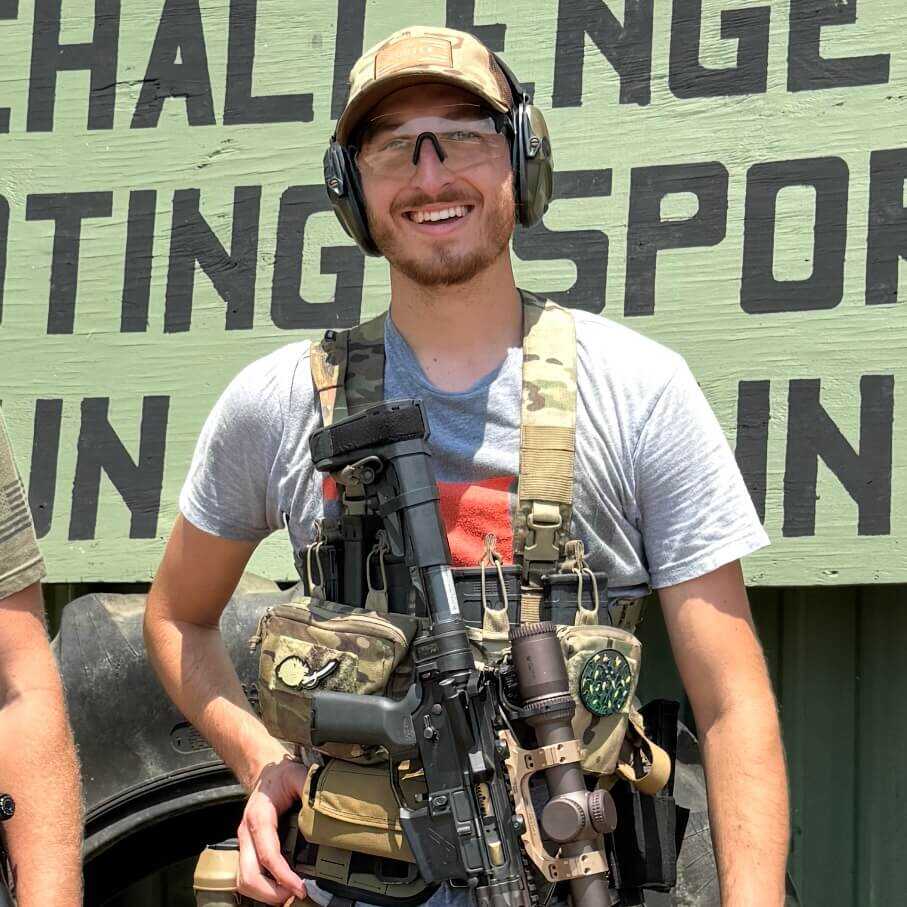
Thanks a lot…rub it in the California Hog Hunter’s face why don’t cha;)
If too much fun was illegal, y’all would be on death row! Keep stacking them hogs!!!
Why do we not see articles from Clay Martin anymore? I Miss him.
Frank